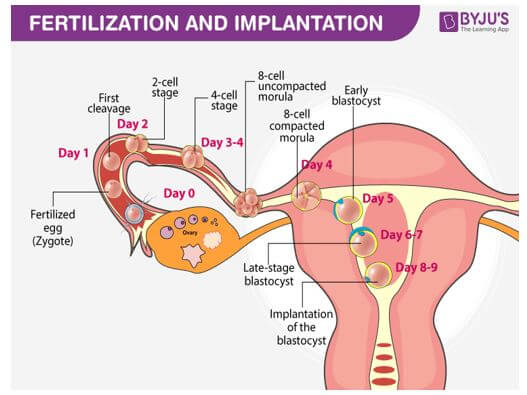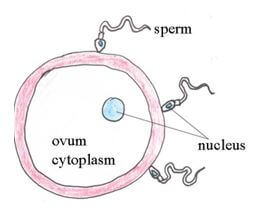- Reproduction in human beings

LIVING THINGS AND THEIR ENVIRONMENT
Reproduction in human beings
What is ovulation?
When a young woman reaches puberty, she starts to ovulate. This is when a mature egg or ovum is released from one of the ovaries. The ovaries are the two female reproductive organs found in the pelvis. If the egg is fertilized by a sperm as it travels down the fallopian tube, then pregnancy occurs. The fertilized egg attaches to the lining of the uterus. The placenta then develops. The placenta transfers nutrition and oxygen to the fetus from mother. If the egg does not become fertilized, the lining of the uterus (endometrium) is shed during menstruation.
The average menstrual cycle lasts 28 days. The cycle starts with the first day of one period and ends with the first day of the next period. The average woman ovulates on day 14. At this time, some women have minor discomfort in their lower abdomen, spotting, or bleeding, while others do not have any symptoms at all.
A woman is generally most likely to get pregnant (fertile) if she has sex a few days before, and during ovulation.
Menstrual Cycle
Each month during the years between puberty and menopause, a woman’s body goes through a number of changes to get it ready for a possible pregnancy. This series of hormone-driven events is called the menstrual cycle.
During each menstrual cycle, an egg develops and is released from the ovaries. The lining of the uterus builds up. If a pregnancy doesn’t happen, the uterine lining sheds during a menstrual period. Then the cycle starts again.
Menstrual phase
The menstrual phase is the first stage of the menstrual cycle. It’s also when you get your period.
This phase starts when an egg from the previous cycle isn’t fertilized. Because pregnancy hasn’t taken place, levels of the hormones estrogen and progesterone drop.
The thickened lining of your uterus, which would support a pregnancy, is no longer needed, so it sheds through your vagina. During your period, you release a combination of blood, mucus, and tissue from your uterus.
You may have period symptoms like these:
- cramps
- tender breasts
- bloating
- mood swings
- irritability
- headaches
- tiredness
- low back pain
On average, women are in the menstrual phase of their cycle for 3 to 7 days. Some women have longer periods than others.
Identifying common issues related to Menstrual cycle
Every woman’s menstrual cycle is different. Some women get their period at the same time each month. Others are more irregular. Some women bleed more heavily or for a longer number of days than others.
Your menstrual cycle can also change during certain times of your life. For example, it can get more irregular as you get close to menopause.
One way to find out if you’re having any issues with your menstrual cycle is to track your periods. Write down when they start and end. Also record any changes to the amount or number of days you bleed, and whether you have spotting between periods.
Any of these things can alter your menstrual cycle:
- Birth control. The birth control pill may make your periods shorter and lighter. While on some pills, you won’t get a period at all.
- Pregnancy. Your periods should stop during pregnancy. Missed periods are one of the most obvious first signs that you’re pregnant.
- Uterine fibroids. These noncancerous growths in your uterus can make your periods longer and heavier than usual.
- Eating disorders. Anorexia, bulimia, and other eating disorders can disrupt your menstrual cycle and make your periods stop.
Here are a few signs of a problem with your menstrual cycle:
- You’ve skipped periods, or your periods have stopped entirely.
- Your periods are irregular.
- You bleed for more than seven days.
- Your periods are less than 21 days or more than 35 days apart.
- You bleed between periods (heavier than spotting).
If you have these or other problems with your menstrual cycle or periods, talk to your healthcare provider.
Managing issues related to the menstrual cycle
- stopping smoking
- using heating pads, hot water bottles, or warm baths to ease pain
- trying gentle forms of exercise, such as walking
- managing stress and making time for relaxation
- avoiding caffeine, alcohol, and refined sugar in the 2 weeks before a period
- getting enough sleep each night
Fertilization and implantation in human beings
“Fertilization in humans refers to the fusion of male and female gametes that facilitates the development of a new organism.”
Fertilization is the natural life process, which is carried out by the fusion of both male and female gametes, which results in the formation of a zygote. In humans, the process of fertilization takes place in the fallopian tube.
During this process, semen comprising thousands of sperms are inseminated into the female vagina during coitus. The sperms move towards the uterus and reach the opening of the fallopian tube. only a few sperms will succeed in reaching the opening of the fallopian tube.
Both sperm and egg can show their vitality only to a limited period. Sperm is alive for 48-72 hours in a female reproductive system, whereas the egg can be fertilized for 24 hours before it is released.
Only one sperm will succeed in fertilising the ovum, by penetrating its cell membrane and depositing the male genetic material into the female cell, where the two nuclei fuse. The fertilised ovum (zygote) immediately becomes resistant to penetration by any other sperm arriving later. After fertilisation occurs, the zygote remains in the fallopian tube for about 72 hours, and during this time it develops rapidly, as you will see in the next section.
Early development of the embryo
From the moment of fertilisation until the eighth week of pregnancy, the developing human is called an embryo.
While these changes are taking place in the early embryo, it is moving along the fallopian tube towards the uterus. This takes five to seven days.
Between five to seven days after fertilisation, the blastocyst reaches the uterus and embeds itself in the thickened endometrium (lining of the uterus). This process is called implantation, and if the embryo survives it is the beginning of a pregnancy. However, the embryo may not implant, or it may not survive for more than a few days. In this case, it is shed from the uterus as the endometrium breaks down, and it passes out of the vagina in the menstrual fluid. The loss of a very early pregnancy in this way is very common, and the woman does not even know that she was momentarily pregnant.
Download Living Things and Their Environment - Grade 7 Integrated Science Revision Notes.
Tap Here to Download for 30/-
Get on WhatsApp for 30/-
Why download?
- ✔ To read offline at any time.
- ✔ To Print at your convenience
- ✔ Share Easily with Friends / Students
